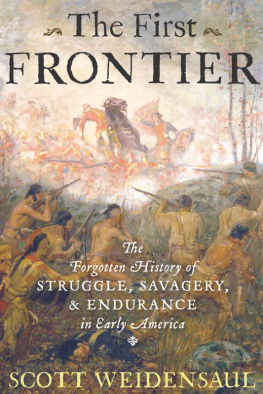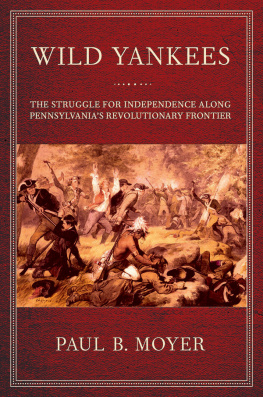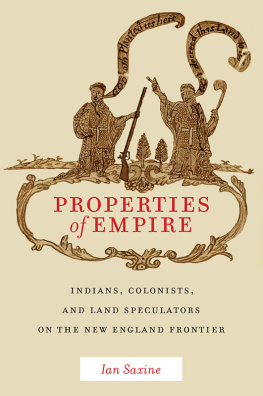Copyright 2012 by Scott Weidensaul
All rights reserved
For information about permission to reproduce selections from this book, write to Permissions, Houghton Mifflin Harcourt Publishing Company, 215 Park Avenue South, New York, New York 10003.
www.hmhbooks.com
Library of Congress Cataloging-in-Publication Data
Weidensaul, Scott. The first frontier : the forgotten history of struggle, savagery, and endurance in early America / Scott Weidensaul. p. cm. Includes bibliographical references and index.
ISBN 978-0-15-101515-3 1. Frontier and pioneer lifeEast (U.S.) 2. East (U.S.)History. 3. East (U.S.)Race relationsHistory. 4. North AmericaHistoryColonial period, ca. 16001775. 5. North AmericaHistory, Military. 6. Indians, Treatment ofEast (U.S.)History. 7. WhitesEast (U.S.)Relations with IndiansHistory. 8. Indians of North AmericaEast (U.S.)History. I. Title. f106.w45 2011 974dc23 2011030600
Book design by Brian Moore
Printed in the United States of America
DOC 10 9 8 7 6 5 4 3 2 1
For Amy, patience personified
Acknowledgments
I am, even more than usual, indebted to my agent, Peter Matson, to whom this subject was of keen interest and whose insight and enthusiasm were mainstays. I was also fortunate to have worked with two peerless editors during the years in which this book was being researched and writtenRebecca Saletan, whose guidance during its formative stages was essential, and Lisa White, who did the heavy lifting as the book came together and moved through editing and production. Lisas deft editing was a joy.
Any writer owes more than he can express to a good copy editor, and I was especially fortunate to have Barbara Jatkolas critical eye on this manuscript. Copyediting is an unsung but crucial process, and Barb saved me from errors of commission and omission, all with good humor and astonishing attention to detail.
Particular thanks to Pete Seward and Jen Johnson, without whom much would have been impossible, and to Ron Freed for his thoughtful first readings, which helped me enormously. A special tip of the hat to Allister Timms at Down East magazine for research assistance on the subject of the Abenaki navy, and to Professor Earl C. Haag for his expertise in early German/Swiss culture in Pennsylvania.
My wife, Amy, to whom this is dedicated, put up with a lot over the past five years. Thanks, sweetheart.
Authors Note: A Word on Words
When quoting original sources, a writer faces a choice between historical accuracy and readability. In general, I have left the original spelling, capitalization, and punctuation intact, although I have made a few exceptions. I modernized the use of u and v, which in the sixteenth century were often reversed (discouered instead of discovered; vse instead of use), as well as the use of i instead of j (iudged instead of judged). Likewise, I modernized the use of fs for the double s in words such as addrefs. In rare cases where more extensive editing was necessary to improve understanding, such changes are bracketed in the text or noted in the citation.
Selected Pronunciation Guide
Klskpe: KLOOS-geh-bah
Kthnto: kTEN-uhn-et-to
Miantonomi: mee-ahn-to-NO-mee
Mol8demak: moh-LAH-de-mahk
Opechancanough: oh-pa-CAN-can-oh
Sattelihu: SAT-a-lee-hyoo
Scarouady: SCAR-roh-ah-dee
Tanaghrisson: tan-ah-GRIS-son
Tsenacommacah: sen-ah-COM-ah-cah
Introduction
On the Hochstetler farm, which in September 1757 sat like an oasis of orchards and fields below the dark forests of the Kittochtinny Hills in eastern Pennsylvania, there was a rhythm to the seasons, and for the young people of the surrounding German community, ebbelschnitz time was one of the highlights of autumn.
The apple trees, planted almost twenty years earlier, hung ripe with fruita testimony to Gods mercy, which, having brought these followers of the Mennonite elder Jakob Ammann out of persecution in Germany and Switzerland, led them to this new land of Pennsylvania, William Penns holy experiment of religious tolerance. Never mind that their neighborsEnglish, Welsh, Scots-Irish, even their fellow Germans, the Lutherans and Reformeds who worshipped together at the union church down the Tulpehocken Valleywere not always the most welcoming, calling them Amish or looking askance at their pacifist ways in these troubled times of war. The Amish community along Northkill Creekthe first of its kind in the New Worldwas strong and growing. Jacob Hochstetler knew they were blessed every time he looked at his wife, his children, and their prosperous farms.
It was harvest time in the orchards. The best apples would be picked with gloved handsnever letting skin touch skin, which would cause the fruit to spoilthen be carefully packed in boxes of straw to be stored away in the cool, dry root cellar, alongside the potatoes and carrots. In the middle of winter, the fruit would be portioned out, like treasures, crisp and dripping juice as though straight from the tree. The other, lesser apples would be ground into sauce or boiled in great iron kettles to make creamy apple butter, while the tartest (along with the windfalls) would be home-milled and pressed for cider, stored in casks that went into the root cellar, too.
But enormous piles of apples lay ready this day for gedaddeschnitz, dried apples that, when soaked in water, would plump up to make fillings for pies and tarts. In the morning, all the children and teens from the surrounding farmsthe Yoders, Hertzlers, Nues, Glicks, Zoogs, and other Amish familiesgathered at the Hochstetlers to help with the chore, as did the Hochstetlers grown children, John and Barbara, who lived on neighboring farms. Working steadily but happilywith a lot of joking and, among the older ones, whatever discreet flirting they could managethe kids pared and sliced the apples with sweet-sticky fingers, cutting them into translucent half-moons that Frau Hochstetler and the women laid out on clean sheets to dry in the warm September sun. The smallest children, too young to be trusted with knives, waved switches to chase away the flies. By dusk, the once immense heaps of red, green, and yellow apples had dwindled to nothing but cores. A feast of a meal had been served, and the older folks kept a cautious but sympathetic eye on the happily chatting teens. A frolic was part of the bargain at ebbelschnitz time, and they had been young once, too.
The conversation that flowed through the darkening evening was almost entirely in German. If Jacob Hochstetler closed his eyes, he could almost imagine he was back in the old country. One tongue he had probably heard only rarely, however, was the swift-tumbling syllables of Lenape, the Algonquian language of the Natives he and the other settlers knew as Delaware Indians. In Lenape, the hills that began just a couple of miles to the north of the Amish farms were keekachtanemin, the endless mountains. The valley itself was tlpewihacki, the land abounding with turtles, and it had been especially beloved by the Lenape. But theyd lost it, just as theyd been forced from the bottomlands along the Delaware River; then from the lower Schuylkill as English Quaker, Irish, and Welsh settlers crowded in; and at last from tlpewihacki itself. Now the anger that had been growing among the Lenape for decades had finally led to war.
Like all the inhabitants of the back parts of the province, as the frontier was known, the Hochstetlers and their neighbors were nervous. The Delaware, Shawnee, and other tribes of the far Ohio countryrefugees from lands in the east, including the Tulpehocken Valleyhad renounced their alliances with the British and lifted the hatchet on behalf of the French. Throughout the previous year, the Endless Mountains had not been merely a boundary between settled lands and the wolf-haunted wilderness; they had been a menacing presence, out of which could come an attack at any time. The militia stationed at small frontier blockhouses such as Fort Northkilla slapdash stockade of ill-fitting logs surrounding a small cabin not far from the Hochstetler farmhadnt prevented a spate of killings and kidnappings the previous winter and spring. The summer of 1757 had been fairly quiet, though, so perhaps, everyone hoped, the worst was over.
Next page






